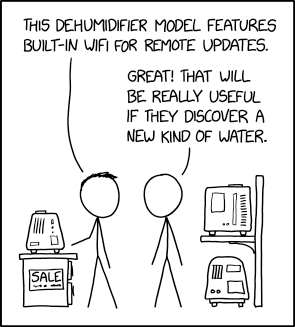welll........ devils advocate.. i could see the wifi being used so the device can be incorporated into the home automation system [climate control]. its not about dehumidifying, its solely about engaging the dehumidifying as needed.
xkcd
A community for a webcomic of romance, sarcasm, math, and language.
Better solution: smart plug
That's right, this would mean that the device has an api to activate or deactivate it through WiFi by sending it commands and I can make it unable to connect to the outside internet right?
Or I can only activate it with the proprietary app that doesn't even have a working schedule?
Connecting to WiFi is good when I have full control but not when the manufacturer does
Yeah, devices that can run fully local are the best. They can be integrated into Home Assistant (or similar), with full control over them. No reliance on a remote server or proprietary app.
To steel-man the argument some more, if you have variable-rate electricity, it could turn on when electricity is cheap.
This can be done with something like Zigbee. Or even simpler: you hook a non-connected device up to a "smart" power socket. No need for the device itself to talk to the outside world.
The solution to too many unnecessarily-connected devices is more connected devices?
The solution is not more but different connected devices so I can decide for myself what needs to be connected and by which protocol. Get the dumbest device on the market, no wifi, no internal clock, maybe not even a humidity sensor and then, if and only if I need to remote control it, for example to put it on a schedule, I can use the cheapest "smart" device on the market to connect it to an in-house machine that can turn it on and off.
You still have to have some device connected to the internet. This just transfers the problem from the humidifier to the outlet.
I run home automation with lights, switches, outlets, heaters and some more and not a single device has internet access. They all use Zigbee (a simple radio protocol) to talk to homeassistant which is open source and hosted on a machine that lives under my desk.
Separating tasks between the dehumidifier and outlet has the advantage that each individual device can be a lot simpler, leaving less attack surface. My power outlet can't read the humidity sensor, it doesn't need to talk to an external server, it doesn't even need to know that the thing connected to it is a dehumidifier. It's just a chip that receives a radio signal and toggles a relay on or off. That's it.
Separating the two concerns also lets me replace the devices separately if one breaks or my requirements change. If I suddenly need wifi or bluetooth instead of Zigbee or if it's for some reason no longer supported by homeassistant, I can just replace a 9€ outlet instead of the whole dehumidifier that could get bricked by the proprietary app losing support.
Zigbee is local and if you really wanted to you can use Home Assistant 100% offline it will be just neutered and basic.
im not sure why all these people jumped from 'wifi' to 'internet' as if they were the same thing. no one should be exposing their automation devices directly to the interwebs
Sadly, many wifi-enabled devices only work with some proprietary cloud-service and even if not, they're only one configuration error (or intentional backdoor) away from talking to the outside. Better have something that isn't physically able to talk to the internet no matter how badly I fuck up its configuration and my firewall.
You could do all that without internet connectivity, just sayin.
Dehumidifiers already do that. They're equipped with hygrometers that kick the machine on or off depending on the relative humidity. It's old tech and it's pretty reliable, wifi isn't really necessary for it.
The built-in hygrometer's not necessarily going to be as good as a well-designed home automation system, especially if the fan's not running all the time, so it has to wait for damp air to diffuse into the machine. It also lets you do other things, like not bother turning the dehumidifier on if there are open windows if you've got some way to detect that, or report the humidity to something that will graph it. It's not stuff that most consumers will care about, but a microcontroller with WiFi like the ESP8266 or ESP32-C3 costs less than an accurate hygrometer chip, so it doesn't make much, if any, difference to the final price, particularly if the product was going to use a microcontroller anyway.
It's ironic that you can implement all this cool automation for a device but in the end still have to manually lug water to it.
Johnson. You're hired!


Yeah, or the manufacturer bricks the device bcz they want to sell you a new one.
